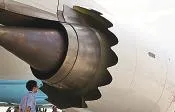THE TRANSFORMATION
2017-09-03CompiledandtranslatedbyMadelineWeng
Compiled and translated by Madeline Weng
Photos by Zeng Jian, Dongfang IC
THE TRANSFORMATION
Compiled and translated by Madeline Weng
Photos by Zeng Jian, Dongfang IC
Do you know that a plane carries nearly nine kilogrammes of weight every square centimetre when it’s up in the air? You may wonder, what materials enable it to endure such great pressure?
飞机“铠甲”变形记
飞机要飞上万米高空,自身每厘米要承受八至九公斤的重量!究竟是怎样的材料,赋予了飞机如此神力?




1903
Era of Exploration: wood that fires up the future
1903 witnessed the invention of the fi rst engined airplane in human history. Created by American aviation pioneers, the Wright brothers, the aviation was mainly made of spruce, a strong and lightweight wood. This material structure had been used up until the end of World War 1. Easy to assemble and requires little propulsive force, this kind of airplanes, however, was only able to fl y at a slow pace of 16 km/h.
探索的时代:木质飞机,飞速慢
1903年,莱特兄弟发明的世界上第一架载人飞机上天。其材料以木材为主,占比达47%,其次是钢和布。这样的材料结构一直沿用到第一次世界大战结束。木质材料的优点有:重量轻,需要的推力较小,以及易加工,易组装。然而,这架飞机的飞行时速只有16公里。
1906
Era of Breakthrough: Here Comes the Iron Man
The invention of duralium in 1906 set scene for the brilliant appearance of the all-metal airplanes. Duralium is hard as well as light in weight. Endowed with harder structure, planes in this era were able to travel more than 600 km an hour, marked a major breakthrough in aviation.
突破的时代:全金属飞机出现
1906年,德国冶金学家发明了硬铝,使后来制造全金属结构的飞机成为可能。硬铝的优点是强度比较高,硬度比较大,刚度比较大,同时较轻。全金属结构飞机加大了结构强度,改善了气动外形,提高了飞机性能。到1940年代,全金属结构飞机的时速已经超过 600公里,实现了飞机制造技术、飞行速度、安全性和飞机强度上的突破。




1950s
Era of Speed: Faster than Sound!
ln the 50s, engineers diverted their attentions to the search for a better heat-resisting material, hence the invention of aviation-grade titanium and stainless steel.
超音速的时代:钛合金研制成功
1950年代以后,飞机材料特别注重耐高温指标,人类开始寻求全新的高强度耐热材料。于是,出现了航空专用的既坚固又耐热的钛合金和不锈钢。
1970s
Era of Advancement: Composite Material, Lighter yet Stronger
A new generation of aviation materials has come into being since the 1970s. The composite material is tougher, lighter, heat-resistant and vibrationreduced and so on. lt allows the aircraft to reduce its weight without compromising its original intensity. Boeing 787 is a good example of adopting composite material, with more than 50% of its body made of the latest aviation material.
When we look back into the history of aviation, we realise that it is always the new materials that boost the creation of a new type of planes. The progress made in the fi eld of manufacturing and testing has also laid solid technological base for the future designs. What will come out next, is defi nitely worth expecting.
纵观人类航空发展史,材料和飞机一直是在相互推动下不断得以发展和改进的。与此同时,制造工艺与测试技术的进步,又为航空新产品的设计与制造提供了物质与技术基础。未来,航空材料的发展依旧让人充满期待。
先进的时代:复合材料出现
自1970年代开始,新一代航空材料复合材料应运而生。复合材料刚度高、质量轻,并具有抗疲劳、减振、耐高温、可设计等优点。它可以使飞机在维持原强度的前提下减轻重量。波音787使用的复合材料,比例在逐渐增大,直到现在它的机身包括机翼都采用的是复合材料,其比例已经超过了50%。
